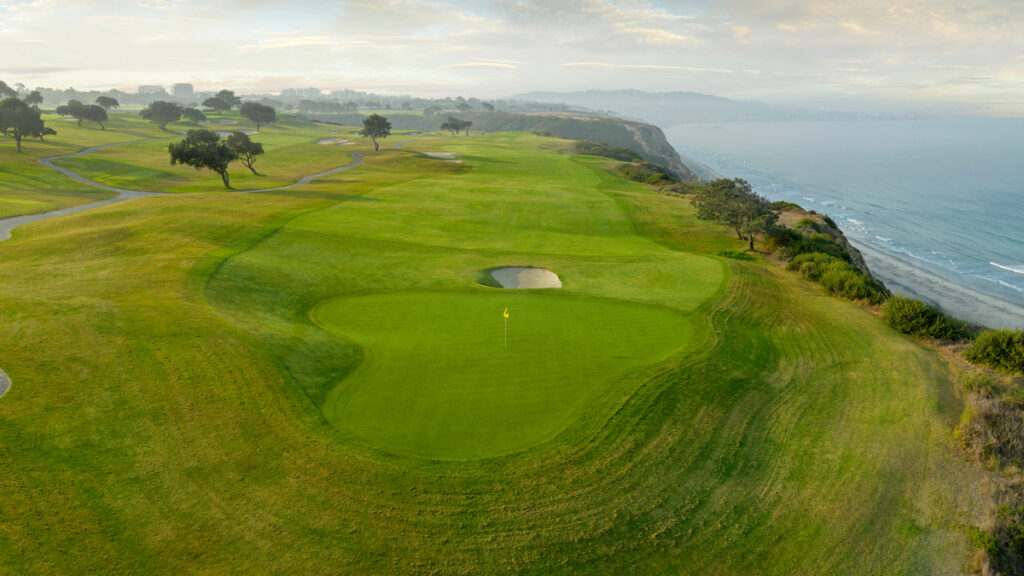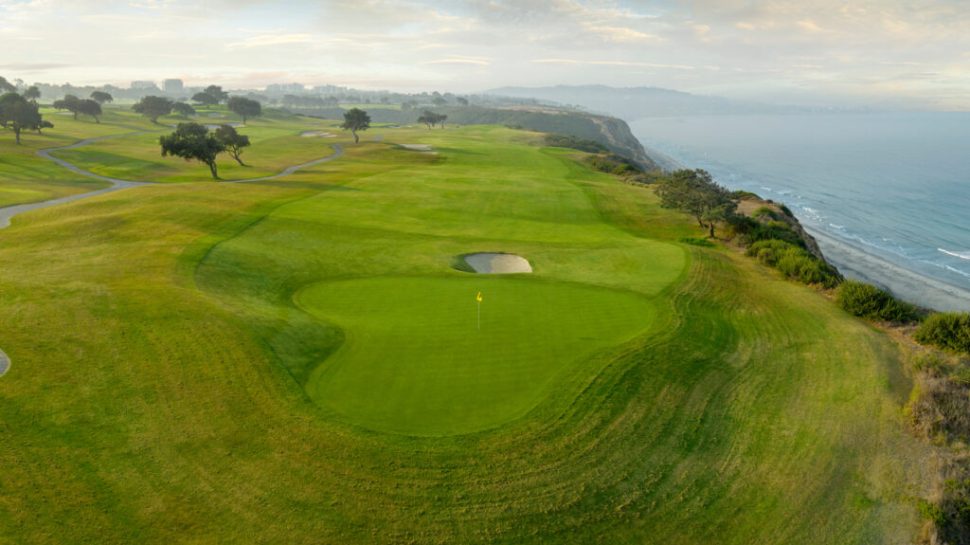
Estimated reading time: 13 minutes
SAN DIEGO, CA The 121st U.S. Open will be played this week on the South Course at Torrey Pines located along the towering cliffs bordering the Pacific Ocean. The championship of American golf returns for the second time — the first having been played in ’08 when Tiger Woods claimed his third title in an epic 91-hole battle against Rocco Mediate.
The South Course is part of a 36-hole complex and the facility is owned and operated by the City of San Diego. Torrey Pines is only the second government-owned facility to host the U.S. Open — the first being Bethpage State Park on Long Island, NY in 2002 and again in 2009.
William P. Bell and his son, William F. Bell, designed Torrey Pines Golf Course’s South Course, which opened for play in 1957. Prior to being shaped for a golf course, the land was part of Camp Callan, a naval training center. Bell’s son finished much of the initial layout after his father’s death, as well as designing the adjoining North Course. Rees Jones completed a redesign of the course in 2002 and provided some updates in 2018-19.
The South will be set up at 7,652 yards and is a par-71. Given the way the South is prepared for the championship the rating is 79.0 with a slope of 151.
The South Course is a familiar venue as it annually hosts the Farmers Insurance Open on the PGA Tour. But that event is usually played in late January and usually provides softer turf conditions. The Open is played traditionally in June and the course will likely play much firmer and faster.
Five architects were asked to provide their perspectives to a range of questions from the manner by which the USGA prepares the course, is bifurcation needed and how the South Course stacks up against the best courses in California, among others.
When you hear the words Torrey Pines — what comes to mind immediately?
PASCUZZO: Tiger and Rocco.
BLASI: Beautiful setting. Missed opportunity.
RICHARDSON: The Bells — William P. and William F, the father and son designers who practiced in very different times from one another, although Torrey Pines began with the elder and completed by the son. It remains one of only a handful of Bell projects where both men had their hand in the design.
CURLEY: Beautiful setting, blimp shots, hang gliders, strangely unremarkable and unmemorable golf course that lacks iconic holes despite the setting. Not finishing with an 18th hole along the oceanfront is strange enough but finishing with a pond on such a site is difficult to justify. The two 18-hole layouts driven by an operational program for public golf — not a quest for the best holes.
COSTELLO: The course on the bluffs overlooking that big lake to the west!
The San Diego-based South Course will play in the range of 7,800 yards for the 103rd U.S. Open this week. Even though both the USGA and R&A have issued updated reports outlining the impact of increased gains from golf clubs and balls — is it inevitable, in short order, the length of certain courses hosting the national championship of American golf will exceed 8,000 yards?
RICHARDSON: I hope not. I have always maintained that we have many ways to defend par, we just haven’t resorted to all of them yet. And, I remain optimistic that we can eventually return to the great William Flynn concept that the three most important hallmarks of the game should be — in this precise order — accuracy, carry and length.
COSTELLO: Yes, it is certainly conceivable certain U.S. Open venues will exceed 8,000 yards but my hope is that we do not cross this threshold. As you note, the governing bodies recognize that the incremental gains due to equipment are having a detrimental impact to the game. Instead, hosting the national championship on courses of similar length to Torrey Pines and shorter would be an opportunity to send a positive message about length.
In broader terms, it is not in the long-term best interests of the game as it is not sustainable given the increasing demands on resources. It also places too much of an emphasis on just one facet of the skill set required for the best players in the world.
CURLEY: It is inevitable if a par-72 is desired it will exceed 8000 yards in time. But I believe a par-70 with the inclusion of several 520 plus yard par 4’s will come first. The USGA is more concerned about protecting “par”. You could argue a par 69 might be more likely than a course exceeding 8000 yards, and that might be better for the game on a big picture view.
PASCUZZO: I hope not, but it will probably end up happening. Keep in mind, it’s not just the equipment that is aiding players, most of today’s elite golfers are amazing athletes. The knowledge, and expert support to help these golfers train their bodies is unlike any previous generation of golfers. The players who are good enough to get to the US Open have been honing their physical and mental skills since they were young and we are witnessing the results of all of that work.
BLASI: Possibly. Some courses don’t have the land to reach that length. But until something is done with regards to equipment, we will continue to see added length as well as other course altering in an effort to combat the distance.
Is bifurcation a needed solution in scaling back the distances gained from golf clubs and balls at the elite level? If such a solution is that straightforward — why do you think there’s reluctance to implement long overdue reforms by the USGA and R&A respectively?
BLASI: I am a proponent of bifurcation. In my opinion the pros play a completely different game than a 20-handicap player and golf courses can be compromised when we don’t recognize that. I can’t speak for why it hasn’t happened, but you hear that it could be fear of lawsuits from manufacturers or just an attachment to the rules as they are.
COSTELLO: My preference would be to cap or reign in the equipment universally instead of bifurcation. While it might be easier to implement at the elite level, I think that would remove one of the keys to what is so appealing about the game when you can evaluate and compare your game to that of the pros and use the “same” clubs and balls.
RICHARDSON: It would be a solution to re-think equipment and balls, but it would take away a treasure we have grown accustomed to — we play the same equipment and that seems to resonate with golfers. But we obviously don’t play the same courses, and this widening of the casual game versus the professional game has now got us to the point where the Torrey Pines I play is a completely different course that we’ll see this year at the U.S. Open.
When you think about it, that is bifurcation! It just doesn’t extend to the equipment. I disagree that there is a reluctance. It’s far too simple to throw out a word like “reforms” and accuse anyone of being reluctant. “Reforms” could take on many forms and degrees of impact, and such measures should not be hastily inflicted on a game that is 500 years old. Right now, we’re measuring and quantifying, and it’s a thoughtful and scientific process. Be patient and go have fun playing your own game.
PASCUZZO: Changes in golf have always come at a glacial pace. More importantly, I don’t care how far the elite players hit the ball or how low they score. Our golf architecture practice is built around doing what’s right for the millions of average golfers out there, not the 200 best players in the world.
CURLEY: I would hope so but I do not see it happening anytime soon. Golfers want to play the same equipment as the pros and if the result is courses get smoked by the elites, unlike the few purists who care, they do not seem to mind. The issue is not a problem with average golfers who just want an edge.
The PGA Championship has been consistently lauded for the manner in which various host sites have been prepared. On the flip side, the USGA has faced an array of criticisms regarding the preparation for the Open Championship in recent years. How fair are those assertions and what possible solutions would you offer the USGA to bolster the presentation of the host venue?
CURLEY: Regarding presentation, as a viewer, my main comment on many recent US Open venues — especially parkland east coast courses — is the consistency of setups is unremarkable and often showcases repetitive properties producing many similar holes that visually create a lack of memorability. Pebble Peach with its very iconic holes and long vistas remains a welcomed exception. I do not see anything driving a diversion from these venues but perhaps in time it will. Course selection is driven by a desire to continue with the blue blood courses as opposed to fresh and visually spectacular designs .
RICHARDSON: Course set up is one of the great variables of the game. Golf is vastly different than tennis, soccer and hockey. In golf, the tournament committee and grounds staff plays a huge role in what the player faces every day. That’s by design. Golf course architects get criticized, and so will the people who set up courses.
We all learn from what we do. But unlike tennis, soccer and hockey, in golf we get to make changes and create an even better and more dramatic playing board the next time around. Golf courses are changing every minute due to hundreds of influences. Go ahead and be a critic, I think we can all take it and learn from it.
PASCUZZO: Well, I think the USGA has done some good things in the way they set up courses, like greatly varying the setup on certain holes during the tournament. I would like to see them take the emphasis off of green speeds and flattening contours in favor of slower speeds and more green contour. Lastly, forget about defending par. Par is rapidly becoming an outdated concept anyway. Provide players the best conditions possible and let’em play. At the end of the week the low score still wins.
COSTELLO: I actually look forward to seeing how the PGA and USGA set up the courses and view this difference as a positive to differentiate between these two major championships.
I had the privilege of working with Sandy Tatum on several projects in California. So whenever Open course conditions receive criticisms, I recall Sandy’s memorable quote when asked about the setup at Winged Foot. “Our objective is not to humiliate the best players in the world. We’re simply trying to identify who they are.”
Open courses have always placed a premium on driving accuracy, with strategically placed bunkers and firm and fast greens. Add in rough, Torrey Pines, and the elements and you have a course primed to test and identify the best golfers in the world.
BLASI: I think the first thing to consider are the venues. In my opinion the USGA venues (past, present and future) are far superior courses to the PGA venues. Then you look at the goal of the setup. The PGA is setting up with a goal of entertainment and challenge. The USGA is trying to define a national champion and often is making it the toughest test in golf.
When making it the toughest test it is much harder to thread the needle or straddle the line of toughness vs fairness. The USGA would be the first to share that there have been times when they missed threading the needle.
Part 2
***
The Participants
Jay Blasi
Owner / Golf Designer
Jay Blasi Design
Los Gatos, CA
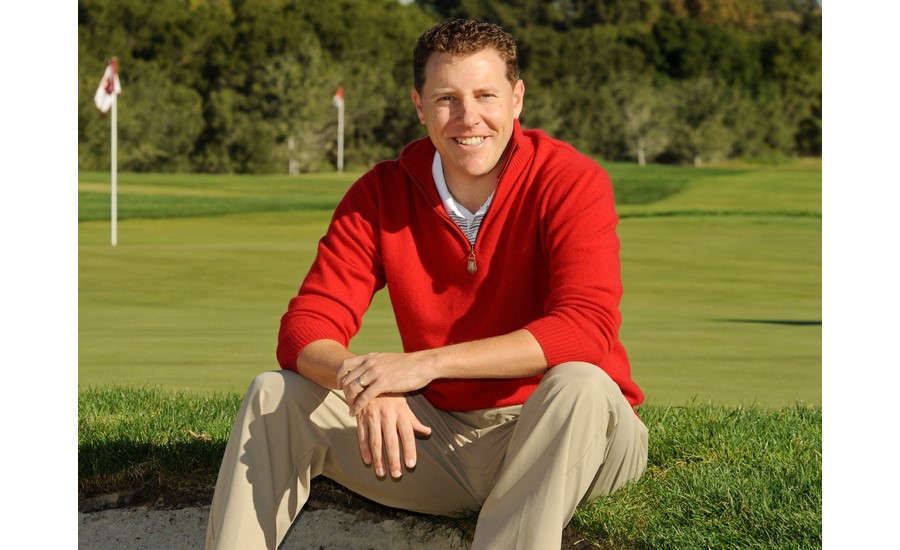
Spent 11 years at Robert Trent Jones II, serving as the driving force behind the designs of Chambers Bay (Washington), The Patriot (Oklahoma) and Stanford University Varsity Golf Training Complex (California). In 2012, Blasi started his own design firm, guided the award-winning major renovations of SentryWorld (Wisconsin) and Santa Ana CC (California) and is currently working in California, Minnesota, Texas and Wisconsin.
In addition to his golf design duties, Jay works with Golfweek Magazine writing articles and hosting rater retreats. www.jayblasi.com
Brian Costello, ASGCA
Principal
JMP Golf Design Group
Belmont, California
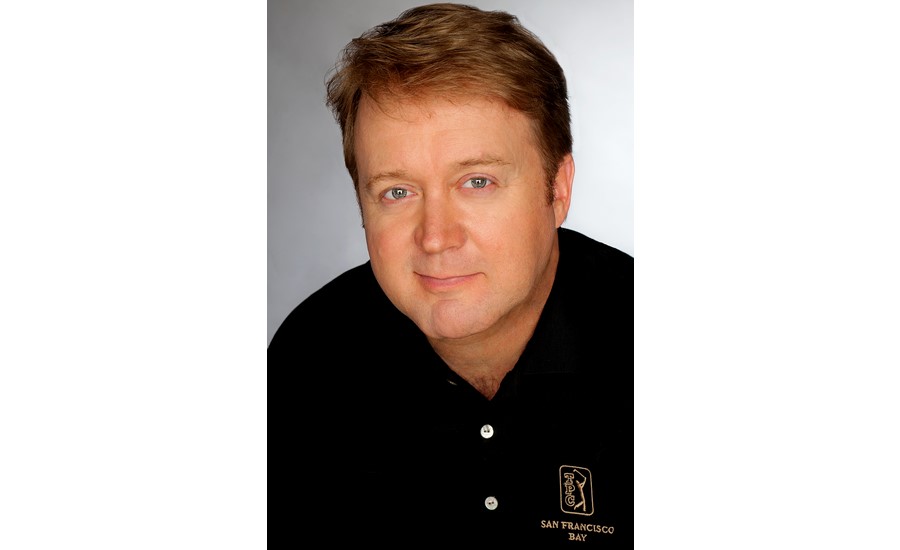
Is in his 32nd year as a golf course architect based in California. He is a member of the American Society of Golf Course Architects (ASGCA) having recently served a three-year term on the Board of Governors. In 1989, Costello joined JMP Golf Design Group and became a Principal of the firm in 1994. Costello has designed many award-winning golf courses in the US and internationally, particularly in Asia.
His original design portfolio includes Whiskey Creek GC, Maryland; Callippe Preserve GC, California; and numerous courses in Asia that have hosted Asian and European Tour Events. His recent renovation work includes Palo Alto Hills G&CC, California and Skamania Lodge GC, Washington. www.jmpgolf.com
Damian Pascuzzo, ASGCA
Golf Course Architect
Pascuzzo & Pate Golf Design
El Dorado Hills, CA
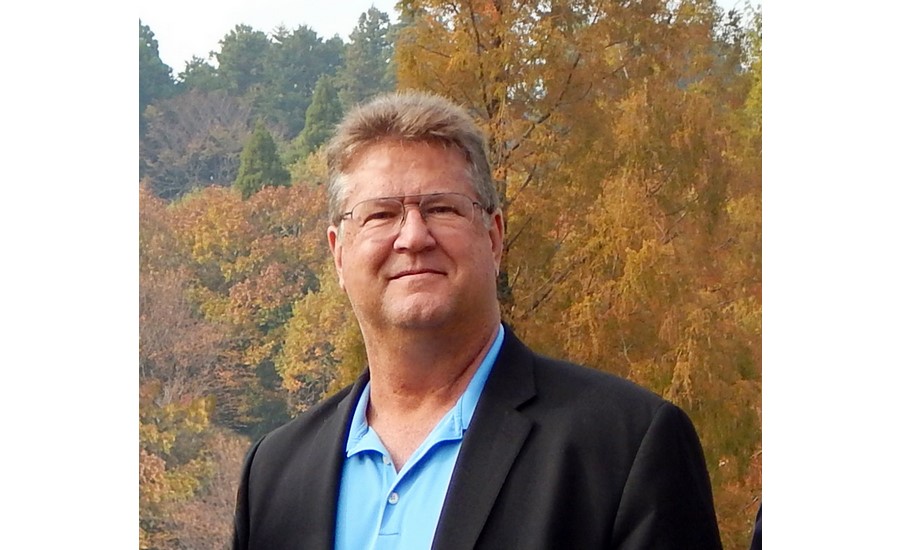
Damian’s four-decade career as a golf course architect started as an associate of Robert Muir Graves leading to an eventual partnership between the two. Since 2003 he has happily teamed with two-time Ryder Cup player, and longtime PGA Tour professional, Steve Pate. Pascuzzo & Pate Golf Design has taken a progressive approach to their design work making it relevant for today’s players and modern lifestyles, while understanding the challenges of the current golf business environment
Their work has taken them throughout the US and Japan. Their remodeling work of Murasaki Country Club in Japan led to the club hosting the 2020 Men’s Japan Open and the 2022 Women’s Japan Open. www.pascuzzopate.com
Forrest Richardson, ASGCA
Senior Golf Course Architect
Richardson / Danner
Phoenix, AZ
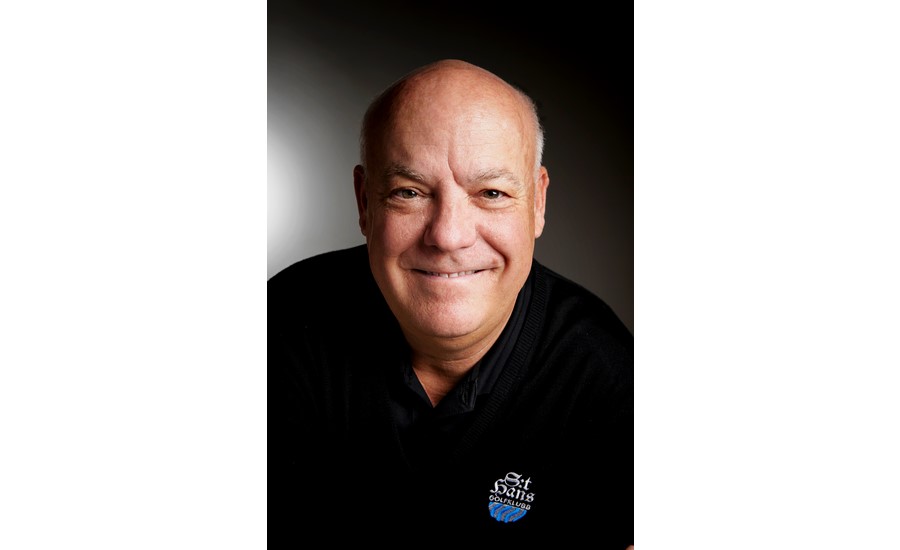
Forrest Richardson is Senior Golf Course Architect with Richardson | Danner, based in Phoenix, Arizona and Northern California. The firm works predominantly in the Western U.S. with current projects in Arizona, Utah, Oregon and Washington.
Forrest is the current President of the American Society of Golf Course Architects (ASGCA) and has remodeled, restored and consulted on more than 50 William P. and William F. Bell courses during his career. www.golfgroupltd.com
Brian Curley, ASGCA
Schmidt-Curley Design
Paradise Valley, AZ
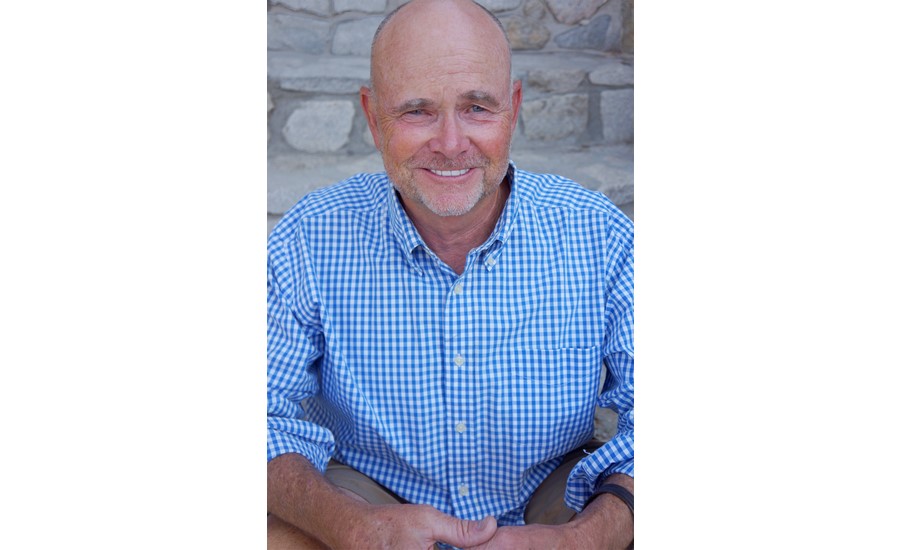
Raised in Pebble Beach where he caddied the iconic courses of the area and driving an early interest in golf course architecture. His background began with Landmark Land Company assisting Pete Dye on many courses including PGA West, and the Kiawah Island Ocean Course. He has spent much of the last 20 years focusing on Asia, including Mission Hill Golf Club where he created 22 courses, 12 with tour signatures and 10 his own design and is now busy mostly in Vietnam. www.schmidt-curley.com
